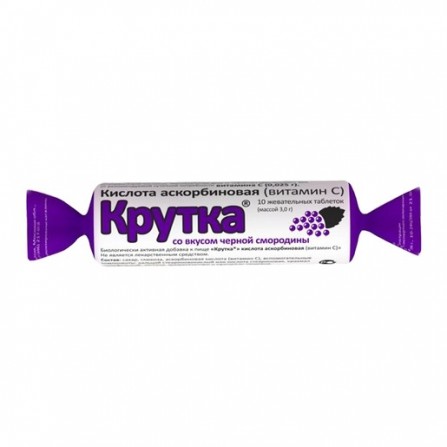Ascorbic to-that black currant twist N10
Condition: New product
1000 Items
Rating:
Be the first to write a review!

More info
The brand
Twist
Composition
Ascorbic acid - 25 mg sucrose (sugar) - 2.064 g glucose (dextrose) - 0.830 g Excipients: potato starch, citric acid, magnesium stearate, flavor identical to natural (orange 585, 590; cherry 95, 061; pear 95, 573 ( duchess 511); lemon 517; mint 614; black currant 522, 554. Food coloring: (annatto E 160 b), carmine (E 120); curcumin (E 100)).
Pharmacological effect
Ascorbic acid plays an important role in the regulation of redox processes, carbohydrate metabolism, blood clotting, tissue regeneration, contributes to an increase in body resistance. Ascorbic acid (vitamin C) is not formed in the human body, and comes only with food. With a balanced and nutritious diet, a person is not deficient in vitamin C.
Indications
Prevention and treatment of vitamin C hypovitaminosis. With an increased need of the body for vitamin C: during the period of active growth in children, pregnancy, breastfeeding, with increased physical and mental stress, fatigue, stressful conditions, during the recovery period after long and serious diseases.
Contraindications
Hypersensitivity to components of Ascorbic acid. You should not assign large doses of patients with increased blood clotting, thrombophlebitis and a tendency to thrombosis, as well as diabetes and conditions accompanied by high blood sugar.
Use during pregnancy and lactation
The minimum daily need for ascorbic acid in the II-III trimesters of pregnancy is about 60 mg. The minimum daily need during breastfeeding is 80 mg. A mother's diet containing an adequate amount of ascorbic acid is sufficient to prevent vitamin C deficiency in an infant (it is recommended not to exceed the maximum monthly requirement for ascorbic acid by a nursing mother).
Dosage and administration
Ascorbic acid is taken orally, after meals. For prophylactic purposes, they are prescribed: Adults - 50-100 mg / day; children 25 mg / day. During pregnancy and lactation at 300 mg / day. for 10-15 days, then at 100 mg / day. For therapeutic purposes, prescribe: Adults-50-100 mg 3-5 times a day; children 50-100 mg 2-3 times a day.The duration of treatment depends on the nature and course of the disease and is recommended by a doctor.
Overdose
Symptoms with prolonged use of large doses (more than 1 g) - headache, increased excitability of the central nervous system, insomnia, nausea, vomiting, hyperacid gastritis, ulceration of the gastrointestinal mucosa, heartburn, diarrhea, difficulty urinating, urine staining in red , hemolysis (in patients with deficiency of glucose-6-phosphate dehydrogenase), inhibition of the function of the insular apparatus of the pancreas (hyperglycemia, glycosuria), hyperoxaluria, nephrolithiasis (from calcium oxalate), damage to the glomerular renal apparatus, moderate pollakiuria (when taking doses of more than 600 mg / day). Reduced capillary permeability (possibly worsening of tissue trophism, increased blood pressure, hypercoagulation, the development of microangiopathies).
Interaction with other drugs
Ascorbic acid increases the concentration of benzylpenicillin and tetracyclines in the blood; at a dose of 1 g / day increases the bioavailability of ethinyl estradiol. Improves the absorption in the intestines of iron preparations (converts ferric iron into ferrous); may increase the excretion of iron while being used with deferoxamine. Acetylsalicylic acid (ASA), oral contraceptives, fresh juices and alkaline drinks reduce absorption and absorption. With simultaneous use with ASA increases the excretion of urine ascorbic acid and decreases the excretion of ASA. ASA reduces the absorption of ascorbic acid by about 30%. Increases the risk of crystalluria in the treatment of short-acting salicylates and sulfonamides, slows the kidneys excretion of acids, increases the excretion of drugs having an alkaline reaction (including alkaloids), reduces the concentration of oral contraceptives in the blood. Increases the overall clearance of ethanol, which, in turn, reduces the concentration of ascorbic acid in the body. Quinoline preparations (fluoroquinolones, etc.), calcium chloride, salicylates, glucocorticosteroids with prolonged use deplete the reserves of ascorbic acid. With simultaneous use reduces the chronotropic effect of isoprenaline. With prolonged use or use in high doses may disrupt the interaction of disulfiram-ethanol.In high doses, it increases renal excretion of meksiletin. Barbiturates and primidone increase the excretion of ascorbic acid in the urine. Reduces the therapeutic effect of antipsychotics (phenothiazine derivatives), tubular reabsorption of amphetamine and tricyclic antidepressants.


